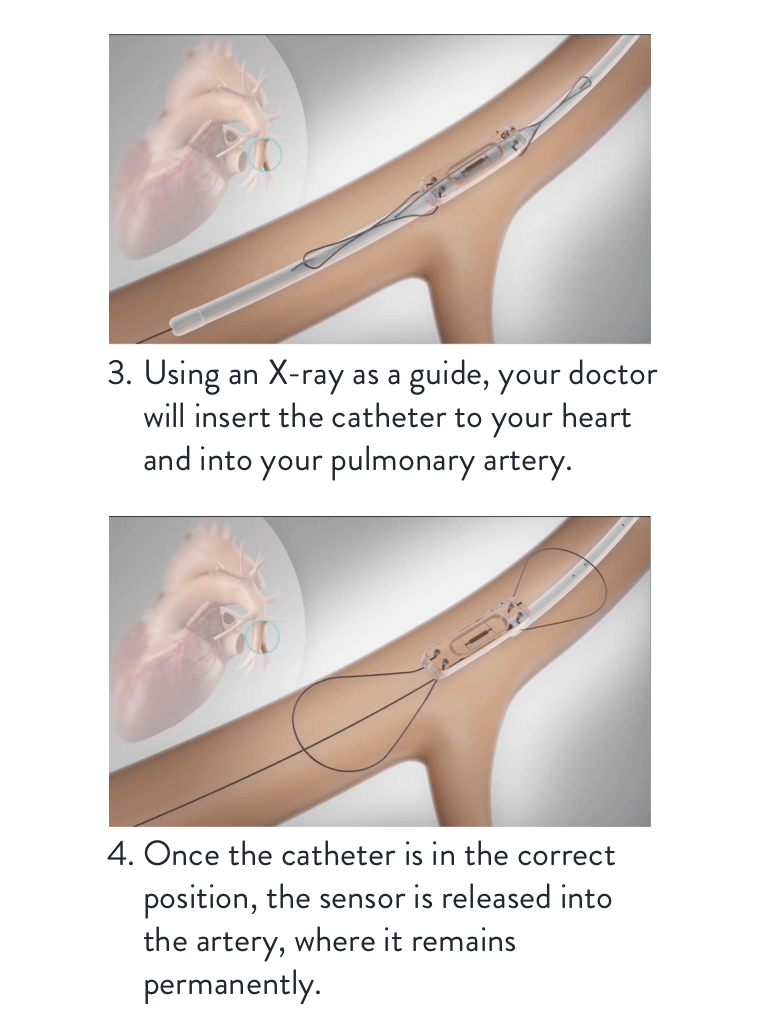CardioMEMS™ HF System: Getting Started Guide
Preparing for Implant Procedure
Once you are identified as an appropriate candidate for the CardioMEMS HF System, you will be scheduled for an implant procedure.



How do I prepare for the CardioMEMS HF System?
Your care team will discuss any changes you will need to make to your medications and daily routine.
Before the implant, you will be trained on how to take daily pressure readings.
What happens during the procedure?
The CardioMEMS™ PA Sensor is inserted into the pulmonary artery during a right heart catheterization.
- You may receive mild sedation to keep you comfortable.
- Your doctor will make a small incision and place the catheter into a vein in your neck or groin.
- Using an X-ray as a guide, your doctor will insert the catheter to your heart and into your pulmonary artery.
- Once the catheter is in the correct position, the sensor is released into the artery, where it remains permanently.
- The procedure will take an average of 30-45 minutes and most patients will go home the same day.
As with any medical procedure, there are risks associated with implanting the device, although complications are very rare.1

Watch an overview of the CardioMEMS HF System implant procedure
After the procedure, you may have mild pain or bruising at the incision site for a couple of days, but you should be able to resume normal activities soon afterwards.
- You will not feel the sensor in your pulmonay artery
- Since the sensor doesn't contain any batteries, it won't need to be replaced and won't need to be charged
- Your sensor won't interfere with daily activities or other implanted devices like pacemakers or defibrillators2



Implantation of the CardioMEMS PA Sensor is a safe, proven, common procedure.
In clinical studies of heart failure patients, hemodynamic monitoring with the CardioMEMS HF System led to:
Significant improvement in quality of life1
57% Reduction in heart failure hospitalizations3
Improved survival in heart failure patients4-6
Summary
• Insertion of the CardioMEMS PA Sensor via RHC is a safe, proven, and commonly performed procedure.
• You will not feel the sensor, nor will it interfere with any of your other devices.2
• Your care team will use the CardioMEMS HF System data to proactively treat your heart failure to keep you out of the hospital.
These materials are not intended to replace your doctor's advice or information. For any questions or concerns you may have regarding the medical procedures, devices and/or your personal health, please discuss these with your physicians.
References
- Brugts JJ, Radhoe SP, Clephas PRD, et al. Remote haemodynamic monitoring of pulmonary artery pressures in patients with chronic heart failure (MONITOR-HF): a randomised clinical trial [published correction appears in Lancet. 2023 Jun 24;401(10394):2112. doi: 10.1016/S0140-6736(23)01256-4.]. Lancet. 2023;401(10394):2113-2123. doi:10.1016/S0140-6736(23)00923-6
- Abbott data on file.
- Shavelle D, Desai A, Abraham W, et al. Lower rates of heart failure and all-cause hospitalizations during pulmonary artery pressure-guided therapy for ambulatory heart failure. Circulation: Heart Failure. 2020;13(8):229-238.
- Givertz MM, Stevenson LW, Costanzo MR, et al., on behalf of the CHAMPION Trial Investigators. Pulmonary artery pressure–guided management of patients with heart failure and reduced ejection fraction. J Am Coll Cardiol. 2017;70:1875-86.
- Abraham J, et al. Association of Ambulatory Hemodynamic Monitoring with Clinical Outcomes in a Concurrent Matched Cohort Analysis. JAMA Cardiology. 2019;4(6):556-563.
- Lindenfeld, J, Costanzo, M, Zile, M. et al. Implantable Hemodynamic Monitors Improve Survival in Patients With Heart Failure and Reduced Ejection Fraction. J Am Coll Cardiol. 2024 Feb, 83 (6) 682–694. https://doi.org/10.1016/j.jacc.2023.11.030.
MAT-2400392 v2.0